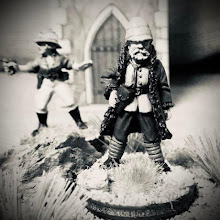"Полундра!"("Polundra!") yells the Imperial Russian Naval Brigade as they charge the enemy.
The continuing chronical of my design of a fictional Anglo-Russian War circa early 20th Century using The Men Who Would be KingsThe Men Who Would be Kings:
"Polundra!' (sometimes also palundra and falundra) is an exclamatory interjection that arose in the days of sailing fleets and originally had the meaning "watch out from above!" It was used in those circumstances when the sailors working on the masts dropped anything from their inventory or tools from a great height onto the deck. The "Polundra" is a battle cry unique to Russian navy/naval infantry and used since at least the 19th Century. During the Great Patriotic War (World War II), the word "Polundra!" served as the battle cry of Soviet marines. Currently, it is most often used as a synonym for the word "beware!" Thanks to Egor Yevsikov for the research and translation.
 The Imperial Russian Naval Brigade from the Sissoi Veliky that got accidentally left in China.
The Imperial Russian Naval Brigade from the Sissoi Veliky that got accidentally left in China.
The Russian Naval Brigade, consisting of crew from the Russian Battleships Sissoi Veliky and Navarin participated, along with allied forces, in the successful defense of the International Legations in Beijing during the "Boxer Rebellion". Sissoi Veliky was a pre-dreadnought battleship built for the Imperial Russian Navy
in the 1890s. The ship's construction was marred by organizational,
logistical and engineering problems and dragged on for more than five
years. She was commissioned in October 1896 with an appalling number of
design and construction faults, and only a few of them were fixed during
her lifetime.
Surprise sally outside of the walls of Beijing into a Boxer camp.
On March 15, 1897 she suffered a devastating explosion of the aft gun turret that killed 21 men. After nine months in the docks of Toulon for repairs, the ship sailed to the Far East to reinforce the Russian presence there. In the summer of 1900, Sissoi Veliky supported the international campaign against the Boxer Rebellion in China. Sailors from Sissoi Veliky and the battleship Navarin participated in the defense of the International Legations in Beijing for more than two months. During the seven weeks of the siege, three men from Sissoi Veliky were killed in action, one died of disease, and twelve were wounded. It was their that the sailors of the Sissoi Veliky worked with the 5th East Siberian Rifle Regiment and built a lasting trust and bond.
Sissoi Veliky
In fact, while celebrating the relief of the Legations with the 5th E. Siberian Rifles, the sailors were not informed of the imminent departure of the Sissoi Veliky and were left behind. Unknowingly, they were off the muster rolls of the battleship but fortunately their commanding officer, Kapitan-leytenant (Lieutenant Commander) Yury Andreyev sought out Polkovnik (Colonel) Nikolai Aleksandrovich Tretyakov, commanding the 5th E. Siberian Rifles for help.
Kapitan-leytenant Yury Andreyev. Instead of a Naval saber he carries his family's ancestral hunting knife that was given by Tsar Peter the Great and has been passed down through the generations.
To make a long story short, up to Manchuria that is now under Russian control, boarded the South Manchurian Railroad, then to the Trans-Siberian Railroad.
Crossing the Ob River.
It was after crossing the Ob River that in Novosibirsk that they received a telegrammed order for them to head toward the Indian Frontier and join the 2nd Siberian Corps. They were not happy.
Green route is modern.
I painted my Russian Naval troops for the fictional Anglo-Russian War using The Men Who Would be Kings based on their appearance in landing uniform for the Russo-Japanese War. For me, when there are a lot of dark colors, it is a challenge to highlight and make them look realistic instead of just a dark blob at gaming distance. Fortunately the brighter blue collar adds color to the mostly dark blue (Vallejo Dark Prussian Blue) and black. Interestingly, the collar was detachable.
Botsman (Boatswain) Victor Girasimov. The right hand man of Kapitan-leytenant Yury Andreyev.
Kwartirmeister (Quartermaster) Kirill Vanzin. Vanzin has acquired a green, red-piped furashika brimmed cap from the 5th East Siberian Rifle Regiment.
Vanzin has attached the two black silk ribbons from his old peak-less sailor cap and is wearing the M1872 striped undershirt (telnashka). Looking at the pictures I have a little clean-up to do on the stripes of his undershirt.
"Come on men, the 2nd Siberian Corps is this way."
















The answer to your question Neil, obviously, is you cant! (Although to be honest, I was expecting to see Jolly Jack Tars of the RN!) Nice work on these Russkies though - I recently painted the same batch of Copplestone figures as Bolsheviks for the RCW.
ReplyDeleteWho knows? Maybe some Jolly Jack Tars will show up. I’ve had my eye on some Copplestone British Naval.
DeleteNeil
Really fine painting, Neil. Your Russians look great!
ReplyDeleteThanks Jon! I know I’ve said it before but this is the most.fun I have had with a project in a few years. BRW I have been enjoying your remote SCW games with Trwbian.
DeleteNeil
Great looking Naval assault figures, Neil! Reading about the turret mishap really makes one think of how dangerous working in warships really could be.
ReplyDeleteDean,
DeleteIt sure does; I can’t imagine the conditions. Thanks for the compliment on the figures - the Copplestone really paint up nicely.
They look so good—and so determined!
ReplyDeleteRegards, James
Thanks James!
DeleteTake care,
Neil
Those are tip top. Wonderful work and a fascinating story. Keep 'em coming!
ReplyDeleteThanks Conrad. I’m having a blast with this project!
ReplyDeleteNicely done
ReplyDelete